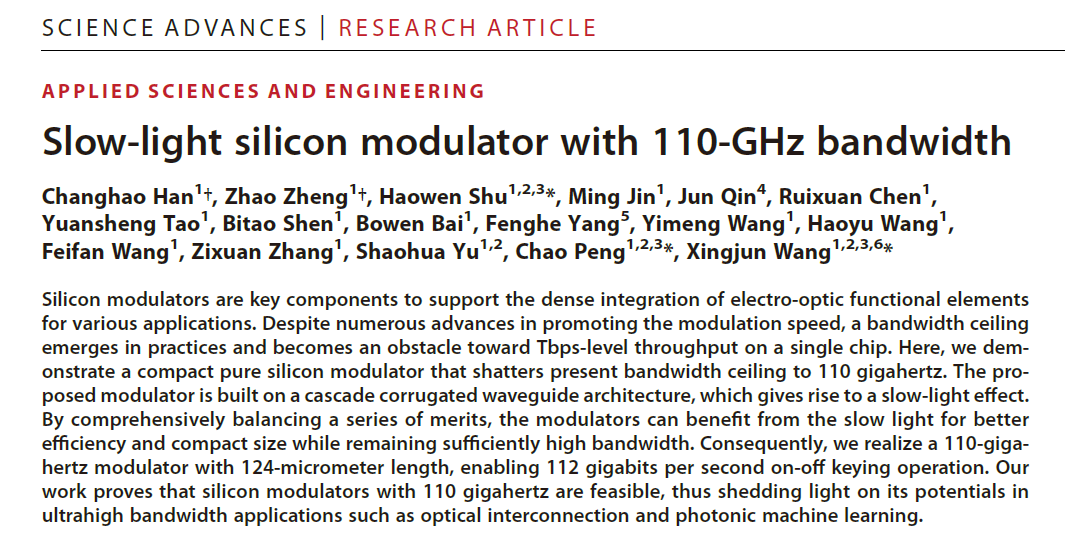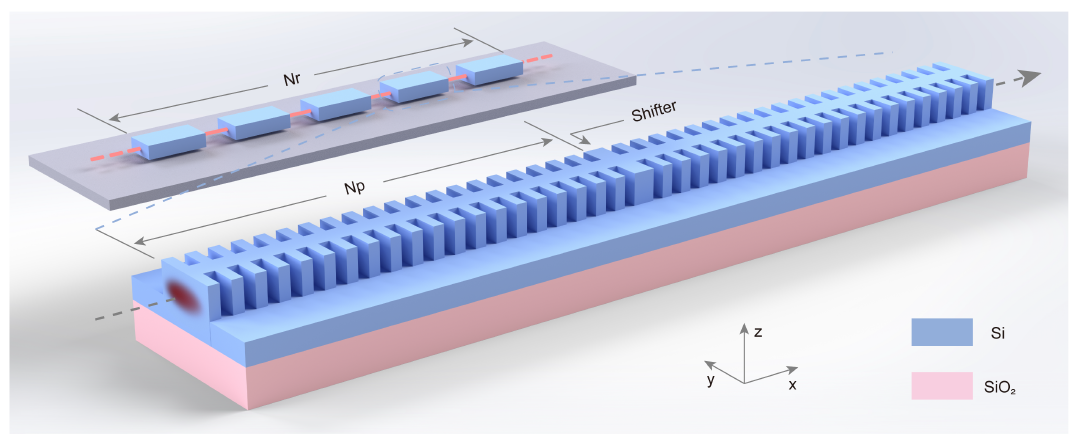Recently, Prof. Xingjun Wang and Haowen Shu at the Center, together with Prof. Chao Peng's team at the School of Electronics, have made a record-breaking breakthrough in ultra-high-speed pure-silicon modulators, realizing the world's first electro-optical bandwidth of 110 GHz, which is the first time that the bandwidth of pure-silicon modulators has been increased to more than 100 GHz internationally since Intel reported the first 1 GHz silicon modulator in Nature in 2004. This pure silicon modulator has the advantages of ultra-high bandwidth, ultra-small size, ultra-large passband and CMOS process compatibility, which meets the needs of future ultra-high-speed application scenarios for ultra-high rate, high integration, multi-wavelength communication, high thermal stability and wafer-level production, and it is an important breakthrough in the field of silicon-based optoelectronics, which provides a key technological support for the application of high-speed, short-distance data centers and optical communication, and is of great significance for the development of the next-generation communication technology. On October 20, the related research results, titled "Slow-light silicon modulator with 110-GHz bandwidth", were published online in Science Advances, a sub-journal of Science.

Screenshot of the article
With the large-scale application of new-generation information technology such as artificial intelligence, big data, cloud computing, Internet of Things, etc., the total amount of global data has shown the development trend of exponential growth, and optoelectronic integration technology represented by silicon-based optoelectronics has become an important development trend of optical communication system. In the silicon-based optoelectronics chip system, the silicon-based modulator can realize the functional conversion of electrical signals to optical signals, and has the advantages of low cost, high integration, CMOS process compatibility, etc., and is the key active device to complete on-chip information transmission and processing. However, limited by the slower carrier transport rate of silicon material itself, the typical value of pure silicon modulator bandwidth is generally 30-40GHz, which is difficult to adapt to the future needs of more than 100Gbaud communication rate, and thus becomes one of the bottlenecks for further development of silicon-based optoelectronics in high-speed field.

Silicon-based modulation structures based on the slow-light effect
In this work, in light of the traditional silicon-based modulator bandwidth constraints, the research team uses silicon-based coupled resonant cavity optical waveguide structure to introduce the slow-light effect and constructs a complete theoretical model of the silicon-based slow-light modulator. Through a reasonable control of the structural parameters to balance comprehensively between the optical and electrical index factors, they achieved further optimization of the performance of the modulator. Based on the CMOS-compatible silicon-based optoelectronics standard process, the research team has designed and prepared an ultra-high-bandwidth silicon-based slow light modulator operating at a communication wavelength of about 1550 nm in a pure silicon material system, realizing an ultra-high electro-optical bandwidth of 110 GHz, which breaks the upper limit of the bandwidth of pure silicon-based modulators so far, and at the same time, shortens the size of the modulation arm to hundreds of micrometers, which enables the modulator to operate at the communication wavelength of about 1550 nm with a simple OOK modulation without the need of a DSP. It’s algorithmic cost and signal latency were reduced while maintaining a high degree of homogeneity in multi-wavelength communication performance over a large optical passband as wide as 8 nm. The research team has achieved a quantum leap in bandwidth performance of silicon-based modulators without introducing heterogeneous materials and complex processes, and can realize low-cost wafer-scale mass production, demonstrating the great value of silicon-based optoelectronics in the field of next-generation ultra-high-speed applications.

Performance characterization of ultra-high bandwidth silicon slow light modulators
Co-first authors of the paper are Changhao Han, a PhD graduate of the Center's Class of 2023 (now a postdoctoral researcher at UC Santa Barbara), and Zhao Zheng, a PhD candidate of the Class of 2019 in the School of Electronics. Prof. Xingjun Wang of the Center, Prof. Chao Peng of the School of Electronics, and Researcher Haowen Shu of the Center are the corresponding authors of the paper. Key collaborators also include Center associate researcher Bowen Bai, postdoctoral researcher Ruixuan Chen, doctoral graduates Ming Jin and Yuansheng Tao, doctoral students Bitao Shen, Yimeng Wang and Haoyu Wang, postdoctoral students Feifan Wang and Zixuan Zhang from the School of Electronics, as well as associate professor Jun Qin from the Beijing University of Information Science and Technology (BUIST), and associate researcher Fenghue Yang from the Zhangjiang Laboratory. Academician Yu Shaohua of Pengcheng Laboratory participated in this work and gave important guidance. This work was done by the State Key Laboratory of Regional Optical Fiber Communication Network and Novel Optical Communication System, School of Electronics, Peking University as the first unit.
This project was supported by the Key Research Program Project of the Ministry of Science and Technology, the National Natural Science Foundation of China, and the Natural Science Foundation of Beijing Municipality.
Link to the original paper:
https://www.science.org/doi/10.1126/sciadv.adi5339

